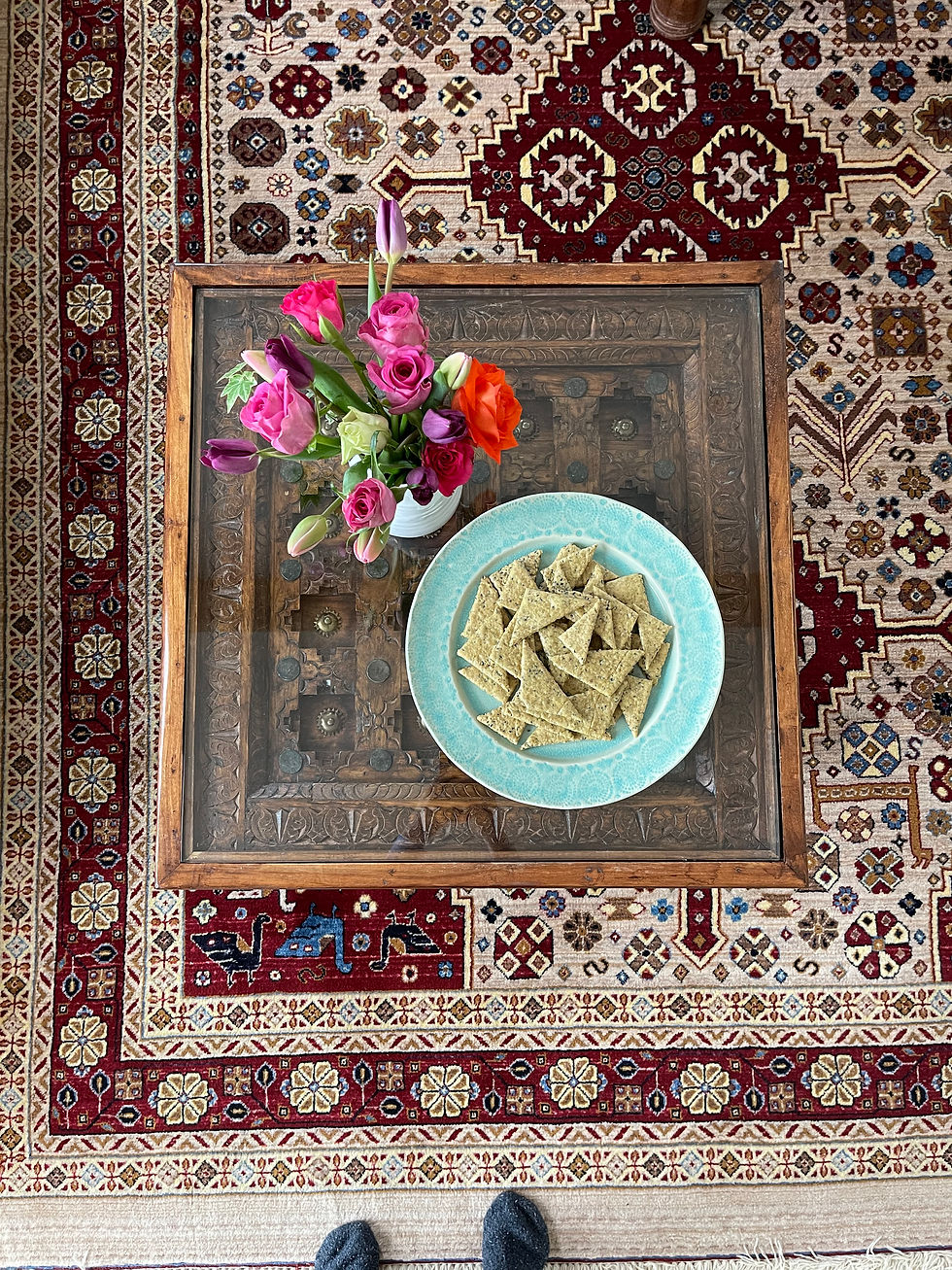Ratatouille - Autumns Treasure
- Carrie Lavie

- Sep 23
- 4 min read

Ratatouille
Having recently returned from France, I thought I would post this beautiful and favourite recipe to make at this time of year, when all of the autumn goodness is out at the famers market, the final expression of summer. Soon, the plants will wither, be touched by frost, and only a few hearty gourds will be remaining. This is a soft, warm, delicious dish full of the seasons vegetables, gently slow cooked to a richness.
One year, in French, along with an expert ratatouille maker, we cooked a huge batch outside in a large portable paella pan. Batch by batch we sauteed each element then brought them all together in an extra large le crueset to simmer with a good bunch of fresh herbs. Truly memorable, yeilding the most beautiful ratatouille with a flavour that was embuded by all of the joy of the undertaking. Deep companionship flourishes along with the dish when such life-ful activity comes into being. I hope that you will find the same soul nourishment from this dish.
From Julia Child's "Mastering the Art of French Cooking," (with my notes in square brackets).
"Ratatouille perfumes the kitchen with the essence of Provence and is certainly one of the great Mediterranean dishes. As it is strongly flavoured it is best when it accompanies plain beef or lamb, pot-au-feu, or plain roast, broiled, or sautéed chicken. "
[For a vegetarian option, ratatouille is excellent served with polenta, roasted tofu, lentil pilaf, or lentil loaf, among other entrees.]
"A really good ratatouille is not one of the quicker dishes to make, as each element is cooked separately [this step is important] before it is arranged in the casserole to partake of a brief communal simmer. This recipe is the only one we know of which produces a ratatouille in which each vegetable retains its shape and character. Happily a ratatouille may be cooked completely the day before it is to be served, and it seems to gain in flavour when reheated.
For 6 to 8 people
1 lb. egglplant
1 lb zucchini
A 3-quart, porcelain or stainless steel mixing bowl
1 tsp salt
A 10- to 12- inch enamelled skillet
4 tbsp olive oil, more if needed
1/2 lb. (about 1 1/2 cups) thinly sliced yellow onions
2 (about 1 cup) sliced green bell peppers
2-3 tbsp olive oil, if necessary
2 cloves garlic, minced
Salt and pepper to taste
1 lb. firm, ripe, red tomatoes, peeled, seeded, and juiced (about 1 1/2 cups pulp)
A 2 1/2 quart fireproof casserole about 2 1/2 inches deep
3 tbsp minced parsley
Peel the eggplant and cut into lengthwise slices 3/8 inch thick, about 3 inches long, and 1 inch wide. Scrub the zucchini, slice off the two ends, and cut the zucchini into slices about the same size as the eggplant slices. Place the vegetables in a bowl and toss with the salt. Let stand for 30 minutes. Drain. Dry each slice in a towel.
One layer at a time, sauté the eggplant, and then the zucchini in hot olive oil for about a minute on each side to brown very lightly. Remove to a side dish.
In the same skillet, cook the onions and peppers slowly in olive oil for about 10 minutes, or until tender but not browned. Stir in the garlic and season to taste.
Slice the pulp into 3/8 inch strips. Lay them over the onions and peppers. Season with salt and pepper. Cover the skillet and cook over low heat for 5 minutes, or until tomatoes have begun to render their juice. Uncover, baste the tomatoes with the juices, raise heat and boil for several minutes, until juice has almost entirely evaporated.
Place a third of the tomato mixture in the bottom of the casserole and sprinkle over it 1 tablespoon of parsley. Arrange half of the eggplant and zucchini on top, then half the remaining tomatoes and parsley. Put in the rest of the eggplant and zucchini, and finish with the remaining tomatoes and parsley.
Cover the casserole and simmer over low heat for 10 minutes. Uncover, tip casserole and baste with the rendered juices. Correct seasoning, if necessary. Raise heat slightly and cook uncovered for about 15 minutes more, basting several times, until juices have evaporated leaving a spoonful or two of flavoured olive oil. Be careful of your heat; do not let the vegetables scorch in the bottom of the casserole.
(*) set aside uncovered. Reheat slowing at serving time."
[Although this will render a traditional ratatouille, where all elements retain their independent shape, I tend to prefer a softer mix of all of the vegetables, cooked all together, country style. After sautéing each element separately (accept for the tomatoes and garlic which I add directly), I combine them over low heat in a dutch oven, add some fresh thyme and allow it to simmer in its juices until everything is nicely stewed and brought together flavour wise. I also prefer to keep the juices rather than letting them cook off until almost evaporated, due to my Ayurvedic tendency toward favouring soupy, warm and unctuous foods. I find this is more supportive to the digestion, especially given the number of night shades in this dish. This method also takes away some of the finicky aspects of this recipe. But, certainly try her technique if you want to keep things more defined.]





Comments